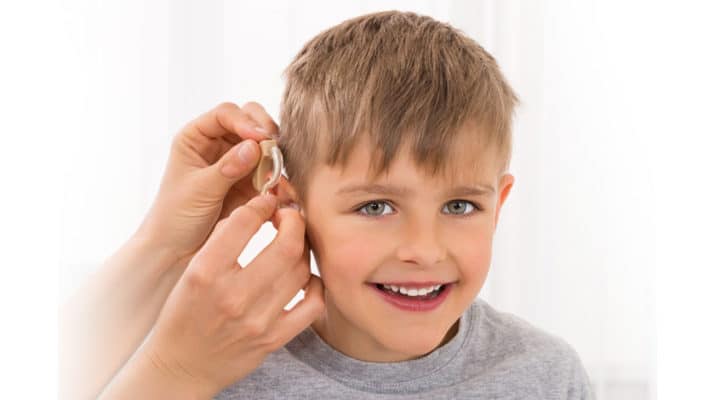Among children aged 6 to 19, 14.9% have some level of hearing loss
By Deborah Jeanne Sergeant
Every baby born in a US hospital receives a hearing screening. Of those, only a fraction — .16% — have some level of hearing loss, according to the Centers for Disease Control and Prevention.
But among children aged 6 to 19, 14.9% have some level of hearing loss because of later onset hearing issues.
Addressing children’s communication needs as young as possible is very important and bears lifelong effects.
“A child’s brain is very elastic in the first three years of life,” said Arlene Balestra-Marko, audiologist and owner of Hear 2 Learn in East Syracuse. “They’re learning language. The brain is starting to wire itself for all of the sensory components. Hearing begins in the womb. A child who is born with hearing loss has not heard clearly for a few months of life. If we cannot give them proper stimulation in the auditory cortex, the brain organizes itself more for visual and other sensory avenues.”
She added that missing aspects of language acquisition without any means of intervention to improve communication can delay children’s learning, cognitive abilities, social development and eventual employment opportunities.
Fitting with hearing aids represents the most widely selected choice for mild to moderate hearing loss; however, some parents of children with severe to profound hearing loss choose to use sign language to complement their children’s growing communication skills.
However children acquire communication skills, it’s important to start early.
“A variety of techniques have been developed that allow us to assess hearing loss, the degree of hearing loss and better enable us to fit hearing aids,” said Doug Brown, audiologist with Audiology Associates, PC in Syracuse. “Primarily, it’s through objective measurements. Instrumentation now allows us to measure what the brain is receiving from the hearing aid and that way we can assess how they’re doing. As they get older, then the abilities of the child themselves to participate improves as well.”
Working with a pediatric otolaryngology professional after they receive their child’s hearing loss diagnosis can help parents navigate.
Brown added that hearing aids for babies differ quite a bit from those intended for adults. To make them appeal to children, hearing aids come in bright colors and patterns, similar to the effect of fun options for glasses. They also have low battery lights so parents know when to charge or change the battery. Their tamper-resistant battery doors help prevent ingestion. Children’s hearing aids are also compatible with hearing assistive technology (HAT) systems that allow parents’ or teachers’ voices to transmit directly from a microphone into the hearing aid, which reduces the effect of ambient noise interfering with the message.
Fitting hearing aids is also different for children compared with adults. Parents are more involved for pediatric fittings and device care, especially for infants who are both incapable of expressing their experience accurately and lack normal hearing experience for comparison.
Audiologist Balestra-Marko added that usually, infants receive a full prescription, unlike adults, who have to slowly adjust to hearing aids. Infants are seen every three to four months for adjustments as they grow. By about age 5 for most children, their ear canals are at adult size.
Manufacturers make children’s hearing aids more durable than their adult counterparts, in case children remove them.
“What I’ve found through my experience is if they’re fitted correctly, there’s no reason for the child not to use it,” Brown said. “Children aren’t born with diapers, yet they wear them. Hearing aids should be the same way. It’s a matter of fitting them correctly and working with the parents to figure out the best way that works for the child to wear them. It can be a challenge.”
Many parents use a clip similar to that of a pacifier to keep hearing aids together and attached to the infant’s clothing so they don’t get lost. Some parents use headbands, hats or aids with attachments that “hug” the child’s ear.
Working closely with a pediatric care specialist helps parents from learning of their child’s diagnosis through ongoing hearing aid care, device adjustments and obtaining the support the child needs at school and for extracurricular activities.
In-school supports are available to make sure children with hearing loss can have every opportunity possible to learn, such as speech therapists and aides to ensure they have their particular needs met. Speech-language pathologists help with lisps and stuttering, but they also help in numerous other ways, find more info on Functional Speech therapy’s website.
“Even though a child may pass a newborn hearing screening, that doesn’t mean they can’t acquire a hearing loss later on as a child or adult,” Brown said. “Parents shouldn’t have the assumption is once they pass the screening they’re home free.”
Though disease-related hearing loss such as mumps and measles have been greatly reduced thanks to immunization, untreated middle ear infection represents a possible cause of childhood hearing loss.
“We want parents to be aware of how children behave when they have a hearing problem,” Brown said. “Moms are the No. 1 indicators. If parents suspect a problem, such as the child is not as responsive or consistent or those types of behaviors, we want that child to be seen.”

